Research Article - Onkologia i Radioterapia ( 2020) Volume 14, Issue 3
Study of a five years survival rate of cancer in Sudanese
Yousif M. Abdallah1,2*, Mujtaba E Abdullah2, Tariq Alqahtani3 and Nouf H. Abuhadi42Radiotherapy and Nuclear Medicine Department, College of Medical Radiological Science, Sudan University of Science and Technology, Khartoum, Sudan
3Department of Medical Equipment’s Technology, College of Applied Medical Science, Majmaah University, Majmaah, 11952, Saudi Arabia
4Department Diagnostic Radiology, College of Applied Medical Sciences, Jazan University, Jazan, Saudi Arabia
Yousif M. Abdallah, Radiological Science and Medical Imaging Department, College of Applied Medical Science, Majmaah University, Majmaah, 11952, Saudi Arabia, Email: y.yousif@mu.edu.sa
Received: 30-Jun-2020 Accepted: 20-Jul-2020 Published: 27-Jul-2020
Abstract
Background: The statistics nowadays are an important aspect of the fighting of the world against cancer. Unfortunately, there is no enough statistical information's about cancer incidence, epidemiology, or survival rates in Sudan, there are only a few knowledge's from the published studies. Material and Methods: This retrospective study has been performed to estimate the overall 5-year cancer survival rate in Sudan was calculated and the factors that could influence the rate were described. The study was based on data from the Radiation and Isotope Centre (RICK) of 160 adult patients with different types of cancer. The patients have been followed up to 2013 with their treatment and death records. Results: The study showed that the total 5-year survival rate in Sudan was 33.75%, with many factors affecting this rate, including patient sex. Conclusion: Increasing knowledge of the disease improves the detection, diagnosis, and treatment of patients, and improves survival. If any carcinogenic patient is diagnosed with cancer, treatment should be determined and administered as soon as possible.
Keywords
Cancer, Radiation, Cancer, Isotope Centre
Introduction
For decades, cancer has focused on scientific research. Increased understanding of the disease will improve the detection, diagnosis, and treatment and enhance patient survival from death [1]. Most cancer therapy advances are the result of wellorganized, retrospective clinical trials (i.e., verified information from previously treated and analysed patients). Current and potential trials (e.g., patient selection, and controlled randomized trials) [2]. The outcome of any clinical trial has to be defined at the clinical stage otherwise; the trial may proceed indefinitely without statistical tests [3]. The five-year survival rate is the kind of survivor rate that is usually calculated by a point of diagnosis to estimate the prognostic of a particular condition. Lead-time variation from earlier diagnosis may affect the 5-year survival rate interpretation. Absolute 5-year survival rates define the percentage of patients having been treated after 5 years of illness. Within five years of diagnosis, the proportion of patients living with illness decides the overall survival rate divided by the percentage of the general population living within five years of age and a similar gender [4,5]. The relative survival rates for five years are well below 100%, as compared to the general population, highlighting over mortality among cancer patients. Contrary to the absolute five-year survival rate, if cancer patients have the same or even higher survival rate than the general public, then the relative five-year survival rate can be equal to and even larger than 100 percent. This can occur if cancer patients can usually be cured or if cancer patients are more privileged than the general population (e.g. socio-economic considerations or access to healthcare) [6-8]. Symptoms and potential causes include lumps, haemorrhages, excessive coughing, unexplained weight loss, and bowel changes. Diseases can occur from cell proliferation or migration to other body parts [9,10]. Benign tumours do not have such contractions. Roughly 10% of these are responsible for cigarettes, and 22% for deaths from cancer [11], obesity, inadequate diet, physical absence, or excessive alcohol intake [12,13]. When we don't smoke, keep our weight own, consume too few alcohols, consume too many vegetables and whole grains, vaccinate under certain conditions of illness, take too few processed meat and avoid excessive exposure to sunlight many cancers can be avoided [14]. Some 8.8 million deaths occurred last year or 15%, and 7% [15]. Men's most common cancers are colon, prostate, colorectal, and stomach cancer and breast, colorectal, and lung cancer in women (Figures 1-3) [16].
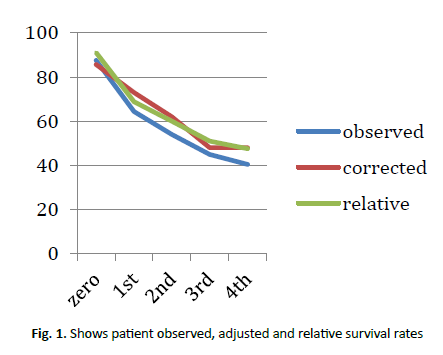
Figure 1. Shows patient observed, adjusted and relative survival rates
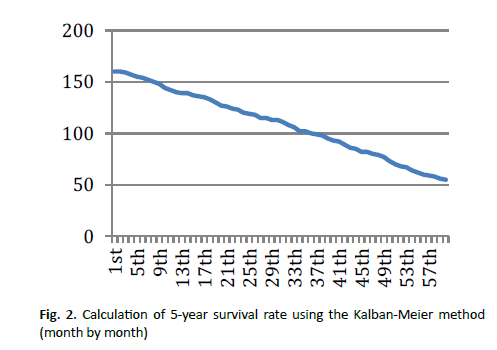
Figure 2. Calculation of 5-year survival rate using the Kalban-Meier method (month by month)
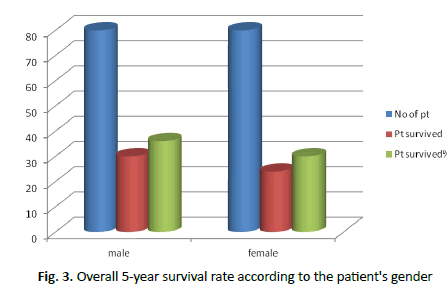
Figure 3. Overall 5-year survival rate according to the patient's gender
Materials and Methods
This study is a Sudanese adult cancer cohort retrospective study. The sample included 160 people aged between 20 years-90 years. The data has been collected from the Khartoum Radiation and Isotope Centre (RICK) patient file system, which includes patient age, jobs, symptoms, and interval of illness, location and magnitude of tumours, years after diagnosis, number of patients deaths year after disease diagnosis, and the last number of patients seen live during treatment. The five-year survival rate, direct method, acting method, and Kalban-Meier method calculations used in this study [17-20].
Results
The overall five-year cancer survival rate is 33.75% for all Sudanese patients (Table 1). The overall five-year cancer survival rate for women and men is 30% and 36% respectively [21-23]. The lowest five-year cancer survival rate was 10% of lung cancer, followed by the brain (15%), breast (25%), cervical (40%), leukaemia (45%), nasopharynx (65%). The five-year cancer survival rate in grade I, grade II, grade III, and grade IV were 76.5%, 24%, 7.5%, and 91.6% respectively. The overall fiveyear cancer survival rates of those patients who treated in the first, second, third, fourth, and fifth months of diagnosis were 68 %, 36.5%, 29.3%, 19%, 12.5%, respectively. The combined multiple treatments had been used including surgery, radiation therapy, and chemotherapy (Figures 4 and 5) [24].
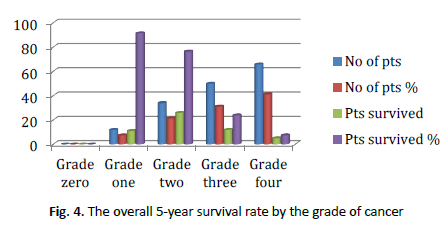
Figure 4. The overall 5-year survival rate by the grade of cancer
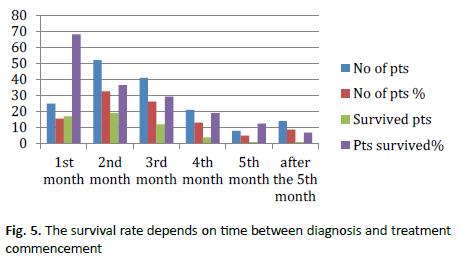
Figure 5. The survival rate depends on time between diagnosis and treatment commencement
| Year after diagnosis (i) | No of alive at beginning of year (li ) |
No of dying during year (di ) |
No of last seen alive during year (wi) |
Effective no. exposed to risk of dying (ri) | Proportion dying during year (qi ) | Proportion surviving year (pi ) | Proportion surviving from list treatment to end year (11 pi ) | Relative survival rate (11 pi/ER) |
|---|---|---|---|---|---|---|---|---|
| 0 | 160 | 20 | 160 | 0.125 | 0.875 | 0.875 | 140 | 0.00089 |
| 1 | 140 | 19 | 139.5 | 0.136 | 0.864 | 0.644 | 120.5 | 0.00113 |
| 2 | 121 | 19 | 119.5 | 0.159 | 0.841 | 0.54 | 100.5 | 0.00158 |
| 3 | 102 | 20 | 100 | 0.2 | 0.8 | 0.455 | 80 | 0.00251 |
| 4 | 82 | 27 | 77.5 | 0.348 | 0.652 | 0.405 | 50.5 | 0.00689 |
| More than 5 | 55 | |||||||
Table 1 : Calculation and standard error of the observed survival rate using the actuarial (lifetable) procedure
Calculation of the 5-years survival by the direct method
The overall 5-years survival rate of cancer in Sudan is 33.57% of all patients when calculated by the direct calculation method. The overall 5-years survival rate in male patients was 36% and in females was 30% (Figures 6-8) [25,26].
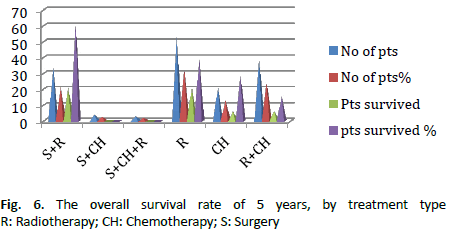
Figure 6. The overall survival rate of 5 years, by treatment type R: Radiotherapy; CH: Chemotherapy; S: Surgery
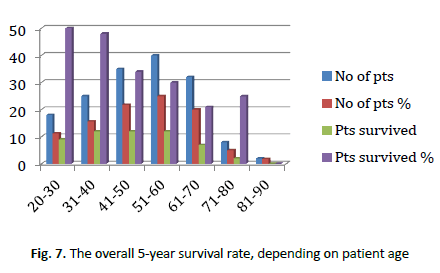
Figure 7. The overall 5-year survival rate, depending on patient age
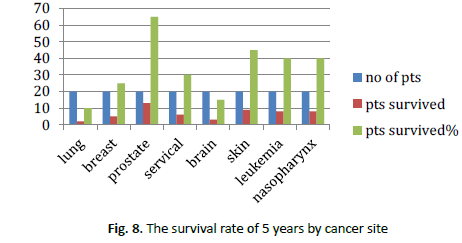
Figure 8. The survival rate of 5 years by cancer site
Calculation of 5-years survival rate by the actuarial (life-table) method
In Table 1, the actuarial (observed) 5-years survival rate is 0.405 or 40.5%. Filtration of other deaths instead of diseases (cancer) calculates the corrected 5-year survival rate at 48 percent [27]. The expected probabilities could be obtained by multiplying the annual probabilities of survival in the overall population life-tables. The correct chance depends on the sex and age of the patient and is taken from the annual registration table. The supposed expected 5-years survival rate for this study is 85%.
The relative 5-years survival rate=observed expected × 100 %=47.6%.
Discussion
In Sudan, the overall 5-year cancer survival rate is 33.7 percent, which is determined by various universal organizations, the top limit of 5-year average cancer survival in developing countries.The average survival rate is also highest for African countries. Women's survival rate is 6% lower than men's. This may require research to determine whether the incidence of cancer in women and men is higher or another factor. The study shows that the shorter time from cancer diagnosis to treatment, the higher the five-year survival rate, the better cancer. The study found that, with the grade, the survival rate decreased gradually. The study showed nobody in grade 0 (in situ tumour) was diagnosed. Unfortunately, some cancer patients are diagnosed in some way, and if they have found opportunities to start treatment, the disease has spread and increased to reduce their chances of survival. The study showed a better and progressive 5-year survival rate for younger patients aged 70-70. The five-year survival rate is above 60-70 in the 71-80-year age group, which may be based on the common behaviour of Sudan's elders, rather than going to the doctor, who prefer to stay home with illness. No survival rates were recorded in the 81-90-year-old group, but this may not mean an increased likelihood of other suspected deaths for all cancer killed at that age. Although many factors depend on the doctor-determined cancer treatment protocol (e.g. grade, location, patient status, etc) a very low survival rate may be required from a different perspective after multi-protocol treatment [28].
Conclusion
Increasing knowledge of the disease improves the detection, diagnosis, and treatment of patients, and improves survival. If any carcinogenic patient is diagnosed with cancer, treatment should be determined and administered as soon as possible. Much can be done in nearly all patients with cancer, which can significantly affect their quality of life (e.g. good physics, good care, and good care). Regular research is very important to determine the likelihood of cancer in hospitals and patients with high-quality cancer and low susceptibility to survival, rather than waiting. Lung cancer is a fatal cancer in Sudan, and it is true in many countries. Prostate cancer is a more common cancer in Sudan, which in many countries is at the end of the fatal cancer list.
Conflict of Interest
The authors declare that there is no conflict of interest with regard to this study.
References
- Cancer survival rate: A tool to understand your prognosis-Mayo Clinic. 2009.
- Gordis L. Epidemiology: with student, consult online access. Philadelphia: saunders. 2008.
- Varricchio G. A cancer source book for nurses. Boston: Jones and Bartlett Publishers. 2004.
- Am Cancer Society. How Is Colorectal Cancer Staged?" 2009.
- Brenner H, Arndt V. Long-term survival rates of patients with prostate cancer in the prostate-specific antigen screening era: population-based estimates for the year 2000 by period analysis. J Clin Oncol. 2005;23:441-447.
- Welch HG, Schwartz LM, Woloshin S. Are increasing 5-year survival rates evidence of success against cancer? JAMA. 2002;283:2975-2978.
- Gloeckler Ries LA, Reichman ME, Lewis DR, Hankey BF, Edwards BK. Cancer survival and incidence from the surveillance, epidemiology, and end results (SEER) program. Oncologist. 2003;8:541-552.
- Cosetti M, Yu GP, Schantz SP. Five-year survival rates and time trends of laryngeal cancer in the US population. Arch Otolaryngol Head Neck Surg. 2008;134:370-379.
- Ferlay J, Shin HR, Bray F, Forman D, Mathers C, et al. Estimates of worldwide burden of cancer in 2008: GLOBOCAN 2008. Int J Cancer. 2010;127:2893-2917.
- Hamad HM. Cancer initiatives in Sudan. Ann Oncol. 2006;17:32-36.
- Hidayatalla A, Rahman EA. The Radiation and isotope Centre, Khartoum, 1967-1984: In: Cancer occurrence in developing countries. IARC Press. 1986.
- Osman TA, Satti AA, Boe OE, Yang YH, Ibrahim SO, et al. Pattern of malignant tumors registered at a referral oral and maxillofacial hospital in Sudan during 2006 and 2007. J Cancer Res Ther. 2010;6:473-477.
- Awadelkarim KD, Mariani CR, Elwali NE. Cancer in the Sudan: an overview of the current status of knowledge on tumor patterns and risk factors. Sci Total Environ. 2012;423:214-228.
- Saeed IE, Weng HY, Mohamed KH, Mohammed SI. Cancer incidence in Khartoum, Sudan: first results from the Cancer Registry, 2009-2010. Cancer Med. 2014;3:1075-1084.
- American Cancer Society. Global Cancer. Facts and Figures. Atlanta: Am Cancer Society. 2011.
- Siegel RL, Miller KD, Jemal A. Cancer statistics, 2015. CA Cancer J Clin. 2015;65:5-29.
- Jemal A, Bray F, Forman D, O'Brien M, Ferlay J. Center M and Parkin DM: cancer burden in Africa and opportunities for prevention. Cancer. 2012;118:4372-4384.
- Chouchane L, Boussen H, Sastry KS. Breast cancer in Arab populations: molecular characteristics and disease management implications. Lancet Oncol. 2013;14:417-424.
- Al Moustafa AE, Al-Awadhi R, Missaoui N, Adam I, Durusoy Ghabreau L, et al. Human papillomaviruses-related cancers. presence and prevention strategies in the middle East and North African regions. Hum Vaccin Immunother. 2014;10:1812-1821.
- Salim EI, Jazieh AR, Moore MA. Lung cancer incidence in the Arab league countries: risk factors and control. Asian Pac J Cancer Prev. 2011;12:17-34.
- Ahmed HG, Osman SI, Ashankyty IM. Incidence of Epstein-Barr virus in pediatric leukemia in the Sudan. Clin Lymphoma Myeloma Leuk. 2012;12:127-131.
- Babiker AY, Eltom FM, Abdalaziz MS, Rahmani A, Abusail S, et al. Screening for high risk human papillomavirus (HR-HPV) subtypes, among Sudanese patients with oral lesions. Int J Clin Exp Med. 2013;6:275-281.
- Idris AM, Ibrahim SO, Vasstrand EN, Johannessen AC, Lillehaug JR, et al. The Swedish snus and the Sudanese toombak: are they different? Oral Oncol. 1998;34:558-566.
- Parkin DM. The global health burden of infection-associated cancers in the year 2002. Int J Cancer. 2006;118:3030-3044.
- Muddathir AM, Kordofani AA, Fadl-Elmula IM. Frequency of BCR-ABL fusion transcripts in Sudanese patients with chronic myeloid leukemia using real-time reverse transcription-polymerase chain reaction. SaudiMed J. 2013;34:29-33.
- American Cancer Society. Cancer in Africa. Atlanta. Am Cancer Society. 2011.
- Ahmed HG, Osman SI, Ashankyty IM. Incidence of Epstein-Barr virus in pediatric leukemia in the Sudan. Clin Lymphoma Myeloma Leuk. 2012;12:127-131.
- Elasbali AM, El Din AH, Abdallah RA, Ahmed HG. Cervical and oral screening for hr-hpv types 16 and 18 among Sudanese women cervical lesions. Infect Agent Cancer. 2012;7:17.



